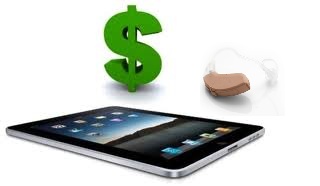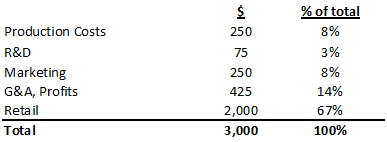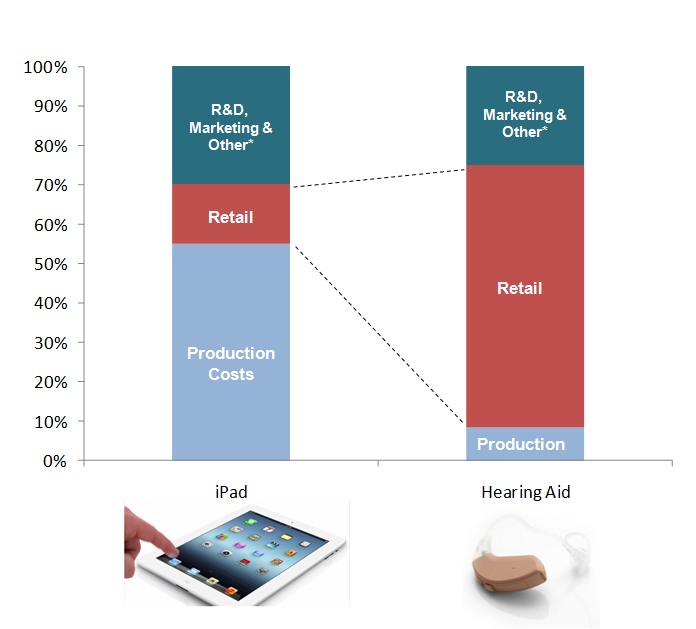… this post was contributed by Ed Belcher*, who put together this eye-opening piece of analysis.
Posted in Affordable Hearing Aids, Audicus, Hearing Aid Cost

Why Does a Hearing Aid Cost Six Times More Than an iPad?
Did you ever wonder why a hearing aid can cost up to 6x more than an iPad? Peeling the onion on the cost structure of both devices reveals an eye-opening comparison into the dynamics of either industry. It can provide us with pointers on where the future price and cost tags could shift and should.
Hearing Aids vs. iPad
Let’s assume a high-end hearing aid costs $1000 to the audiologist when he/she buys it from the manufacturer and consequently gets sold for $3000 to the consumer. Now if you dissect the $1000, based on a study by the German Competition Regulator, the following total cost breakdown emerges:

Now, let’s take a closer look at the iPad: a recent study at the University of California, Irvine took a closer look at the cost structure of a regular iPad and came up with the following segmentation:

Bear with us, as we plot these numbers on a chart:

The manufacturing and distribution costs of a hearing aid are upside-down in comparison to the manufacturing and distribution costs of an iPad.
The iPad is subject to hard, unfettered competition. Its manufacturer profit, marketing, R&D and dispensing costs combined take up 45% of the retail price. The production cost takes the balance (55%) of the retail price.
Most hearing aids are made by the Big-6 consortium which shares patents and does business in a mutually beneficial way. The dispensing businesses sell the aids at a price around 3x their wholesale cost. In that case, the production cost of a hearing aid comprises only 8% of its bundled price. The remaining 92% is made up mostly of dispensing fees, administration salaries, and profits.
Granted, the market structure is different for both products. For instance, the sheer sales volumes of iPads far surpass those of hearing aids: Apple sold 3Mn iPads in the first 72 hours of its recent launch. By contrast, 3Mn units are what the entire hearing aids industry sells in one year. This sales volume allows for different economies of scale, especially when it comes to retail.
Furthermore there is a more involved service component attached to hearing aid dispensing (however not as much as what is traditionally claimed). Hearing aid dispensing, based on personal experiences when shopping in varied businesses for hearing aids, took 1 hour for the exam and discussion of HA options; 1 hour for fitting and training; and up to 2 hours for up to four 30-minute adjustments/training, a total of 4 hours of contact time. Assuming $100 per hour, consultation should yield a total of $400 in dispensing service fees.
In any case, the comparison is still startling and should raise questions on whether the industry is really operating at its most favorable level for the consumer. Let’s look at the next piece of analysis.
What Would a Hearing Aid Cost If it Had the iPad Cost Structure?
The aforementioned hearing aid that a dispenser buys for $1000 costs about $250 to make, as we saw with the previous example. So we start with the $250 production cost.
If the iPad-structure were followed based on the $250 production cost (i.e. 55% of the total) then:
– the final retail price for one hearing aid would be $250 / 0.55 = $455
– If the specialist sells two aids for $455 each and adds $400 for four hours of service, a pair of high-end hearing aids would have a price of $1,310
Let’s pause here and put this figure into perspective: $1,310 is equivalent to 22% of the traditional $6000 for the same pair!
What does this calculation imply on the audiologist revenues per customer? The $455 retail price includes a 15% markup (same as the iPad) of $68.25/aid. The total proceeds to the dispenser is 2*$68.25 + $400 = $537 for each customer served.
The questions that remain are thus:
1.Can industry prosper and sell aids for $387 (0.85*$455)? After all, they have sold millions of aids to the VA with prices decreasing from $375 to $333/aid from 2004 to 2011 respectively, according to Lucille Beck, Director of Audiology, VA, and The Hill
2.Can a specialist prosper with a 15% commission for aids sold and with a $100/hour rate for services (normally 4 hours) during and after the sale of the aids (i.e. $537 of proceeds per customer)?
Tell us what you think; we would love to hear your opinion!
______________________________________________
* Ph.D. EE, Career researcher (retired) in underwater acoustics at the University of Washington
Sources: German Competition Regulator, The Economist, MSN Money, Lucille Beck, Director of Audiology, VA, The Hill
Posted in Affordable Hearing Aids, Audicus, Hearing Aid Cost
